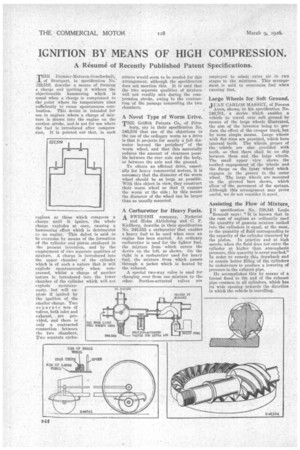IGNITION BY MEANS OF HIGH COMPRESSION.
Page 28

If you've noticed an error in this article please click here to report it so we can fix it.
A Resume of Recently Published Patent Specifications.
THE Daimler-Motoren-Gesellschaft, of Stuttgart, in specification No.' ?22,519, describe a means of forming a charge and igniting it without the objectionable hammering which is usual when a charge is compressed to the point where its temperature rises sufficiently to cause spontaneous combustion. This device is intended for use in engines where a charge of mixture is drawn into the engine on the suction stroke, and is not for use where the fuel is introduced after compression. it is pointed out that, in such
engines as those which compress a charge until it ignites, the whole charge explodes at once, causing a hammering effect which is detrimental to an engine. This defect is said to be overcome by means of the formation of the cylinder and piston employed in the present invention, and by the employment of two separate qualities of mixture. A charge is introduced into the upper chamber of the cylinder which is of such a nature that it will explode spontaneously when compressed, whilst a charge of another nature is introduced into the lower chamber of the cylinder which will not explode spontaneously, but will explode if ignited by the ignition of the sandier charge. Two separate sets of valves, both inlet and exhaust, are provided, and there is only a contracted connection between the two chambers. Two separate carbu
retters would seem to be needed for this arrangement, although the specification does not mention this, It is said that the two separate qualities of mixture will not readily mix during the compression stroke, owing to the contraction of the passage connecting the two
chambers. , A Novel Type of Worm Drive.
TRE Griffith Patents Co., of Pitta'
burg, say in their specification No. 246,534 that one of the objections to the use of the ordinary worm as a drive is that it projects for nearly a full diameter beyond the periphery.— of the worm wheel, and that this materially reduces the amount of clearance possible between the rear axle and the body, or between the axle and the ground.
To obtain an efficient drive, especially for heavy commercial motors, it is necessary that the diameter of the worm wheel should be as large as possible. With this object in view, they construct their worm wheel so that it engages the worm at the side ; by this means the diameter of the wheel can be larger than as usually mounted.
A Carburetter for Heavy Fuels.
A SWEDISH company, Nydqvist
and Holm Aktiebolag and C. F. Rjellberg, describe in their specification No. 246.552 a carburetter that enables a heavy fuel to be used when once an engine has been started. An ordinary carburetter is used for the lighter fuel, the mixture from which enters the device on the left, as shown. On the right is a carburetter used for heavy fuel, the mixture from which passes 'through a jacket which is heated by the exhaust.
A special two-way valve is used for changire-,t' over from one mixture to the other. Suction-actuated valves are employed to stages to the molt is said running fast. admit extra air in two mixtures. This arrangeto economize fuel when
Large Wheels for Soft Ground.
ci:CAN CARLOS MASSEY, of Buenos Aires, shows, in his specification No. 246,701, a device which enables a vehicle to travel over soft ground by means of the large wheels illustrated, the aim of the inventor being to produce the effect of the creeper track, but by more simple means. Large wheels with flat .rims are provided, which have internal teeth. The wheels, proper of the vehicle are also provided with teeth, so that there shall be DO slip between them and the large wheels. The small upper view shows the toothed engagement of the wheels and the flange on the inner wheel which engages in the groove in the 'outer wheel. The large wheels are mounted on the pivoted bars shown, which allow of the movement of the springs. Although this arrangement may prove tisefol, we do not consider it novel.
Assisting the Flow ;r4 Mixture, IN specification No. 238,841 Louis Renault says: "It is known that in the case of engines as ordinarily used the quantity of gaseous mixture sucked into the cylinders is equal, at the most, to the quantity of fluid corresponding to the capacity of the cylinder traversed by the piston. In practice and at high speeds, when the fluid does not enter the cylinder at higher than atmospheric pressure, this quantity is never reached." In order to remedy this drawback mid to ensure better filling of the cylinders; be endeavours to produce a lowering of pressure in the exhaust pipe. He accomplishes this by means of a funnel fixed to the end of the exhaust pipe common to all cylinders, which has its wide opening towards the direction in which the vehicle is travelling.




























